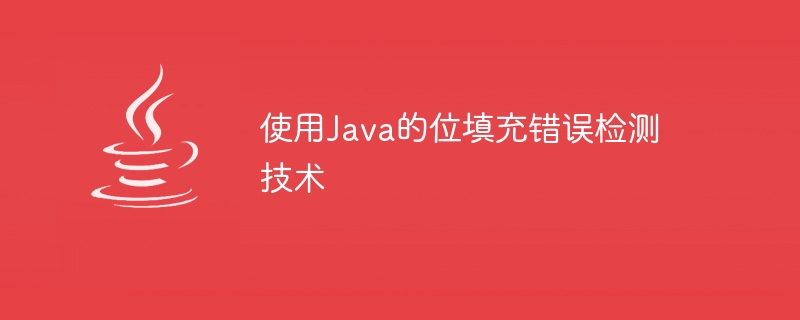使用Java的位元填充錯誤檢測技術
- WBOYWBOYWBOYWBOYWBOYWBOYWBOYWBOYWBOYWBOYWBOYWBOYWB轉載
- 2023-08-29 12:33:06986瀏覽

位元填充是資料通訊系統中使用的一種技術,用於偵測和修正資料傳輸過程中可能發生的錯誤。它的工作原理是向正在傳輸的資料添加額外的位,以便在發生錯誤時進行標記。
在Java中實現位元填充的常見方法是使用標誌位元組(如0x7E)來指示一幀的開始和結束,並使用特殊的轉義位元組(如0x7D)來指示下一幀byte是一個填充位。例如,發送方會在發送的資料中每次出現標誌位元組之前添加一個填充位,這樣標誌位元組就不會在接收方被誤認為是幀的開始或結束。
這是一個如何在 Java 中實現位元填充的範例 -
public static byte[] bitStuff(byte[] data) {
final byte FLAG = 0x7E;
final byte ESCAPE = 0x7D;
// Create a new byte array to store the stuffed data
byte[] stuffedData = new byte[data.length * 2];
// Keep track of the current index in the stuffed data array
int stuffedIndex = 0;
// Iterate through the original data
for (int i = 0; i < data.length; i++) {
byte b = data[i];
// If the current byte is the flag or escape byte, stuff it
if (b == FLAG || b == ESCAPE) {
stuffedData[stuffedIndex++] = ESCAPE;
stuffedData[stuffedIndex++] = (byte) (b ^ 0x20);
} else {
stuffedData[stuffedIndex++] = b;
}
}
return stuffedData;
}
在接收端,您可以使用類似的概念來檢索原始資料。
public static byte[] bitUnStuff(byte[] data) {
final byte FLAG = 0x7E;
final byte ESCAPE = 0x7D;
// Create a new byte array to store the unstuffed data
byte[] unstuffedData = new byte[data.length];
// Keep track of the current index in the unstuffed data array
int unstuffedIndex = 0;
// Iterate through the stuffed data
for (int i = 0; i < data.length; i++) {
byte b = data[i];
// If the current byte is the escape byte, unstuff the next byte
if (b == ESCAPE) {
unstuffedData[unstuffedIndex++] = (byte) (data[++i] ^ 0x20);
} else {
unstuffedData[unstuffedIndex++] = b;
}
}
return unstuffedData;
}
這是位元填充技術的基本範例,可以對其進行增強以處理更多錯誤情況並使用 CRC 或校驗和驗證資料。
範例
當然!以下是如何在簡單程式中使用 bitStuff() 和 bitUnStuff() 方法的範例 -public static void main(String[] args) {
byte[] data = {0x48, 0x65, 0x6C, 0x6C, 0x6F, 0x7E}; // Hello~
byte[] stuffedData = bitStuff(data);
System.out.println("Original Data: "+Arrays.toString(data));
System.out.println("Stuffed Data: "+ Arrays.toString(stuffedData));
byte[] unstuffedData = bitUnStuff(stuffedData);
System.out.println("Unstuffed Data: "+ Arrays.toString(unstuffedData));
}
當你執行這個程式時,它會先呼叫bitStuff()方法來填入原始數據,然後列印出原始資料和填入後的資料。
Then it will call the bitUnStuff() method to retrieve the original data, then it will print the unstuffed data.
範例
對於給定的資料範例
0x48, 0x65, 0x6C, 0x6C, 0x6F, 0x7E,
輸出
您將得到輸出
Original Data: [72, 101, 108, 108, 111, 126] Stuffed Data: [72, 101, 108, 108, 111, 93, 30, 126] Unstuffed Data: [72, 101, 108, 108, 111, 126]
可以看到填充資料多了一個位元組93, 30,這是7E的填充版本。
您也可以看到未填入的資料與原始資料相同,這確認資料已成功檢索,沒有任何錯誤。
以上是使用Java的位元填充錯誤檢測技術的詳細內容。更多資訊請關注PHP中文網其他相關文章!
陳述:
本文轉載於:tutorialspoint.com。如有侵權,請聯絡admin@php.cn刪除

